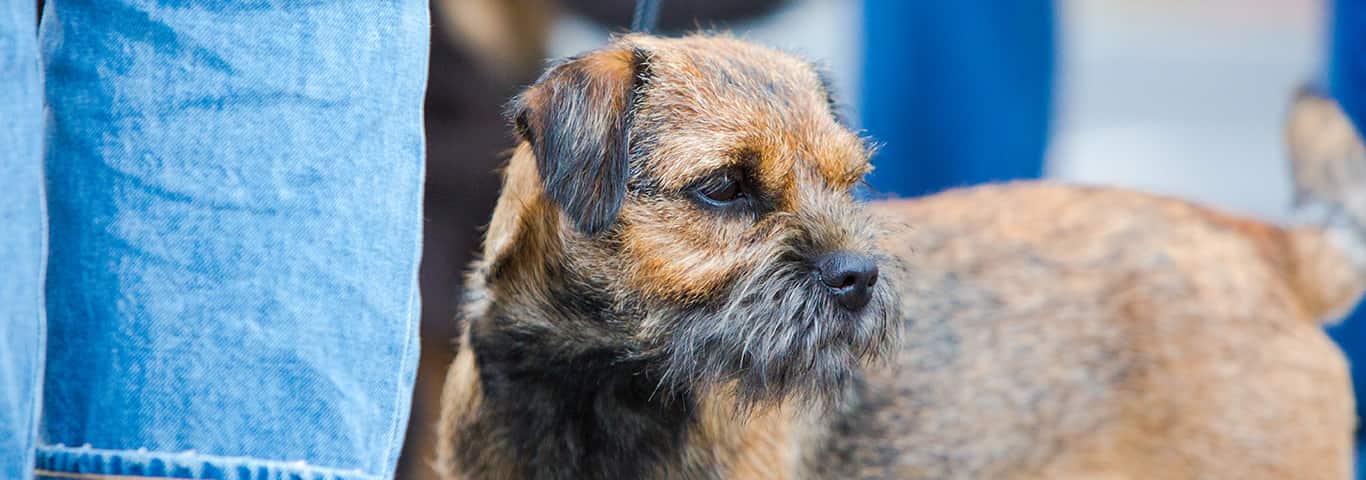He is characterized by an otter head, and his skull is moderately broad and flat with plenty of width between the eyes and ears. His cheeks are slightly full. His expression and body posture give an alert, fearless and determined look that typifies the breed.
Males are 13 to 15 1/2 pounds (six to seven kilograms), and females are 11 1/2 to 14 pounds (five to six kilograms). Border terriers are strongly put together, suggesting endurance and agility.
Colors include red, grizzle and tan, blue and tan, or wheaten. A small amount of white may be allowed on the chest. A dark muzzle is characteristic and desirable.
The Border terrier is atypical of the other terrier breeds. Naturally bred to run peacefully with foxhounds, they were bred for a less dog-aggressive temperament than terriers who hunted primarily on their own.
Although the standard says that "in the field he is hard as nails, game as they come and driving in attack," it also describes the border as "affectionate, obedient, and easily trained." Borders can work and live peacefully with other dogs. If you are looking for just a part-time dog or one to put in the kennel, the border is not for you. They want to be part of the family. Although not constantly demanding your attention, they do want to be with you.
Borders are not big barkers, but will let you know when someone is at the door. Since they were trained to follow fox to the ground, you can expect a border to be a determined digger. A border was bred to think for himself, which can be both his most endearing and most frustrating quality.
Borders are not a high-maintenance breed. They do not require frequent bathing, and toweling off your dog is enough when he is wet and dirty. Too many baths tend to soften the harsh coat that is a natural dirt repellant, and they do not normally have strong odor. Use a slicker brush. A border will shed minimally, but his coat will not shed out completely without help. The border is usually hand stripped twice a year. If you choose to go with the natural look and not strip the coat, it will have a bit more odor than a stripped coat. You can clip the coat, but clipping is not done by many owners.
Borders are active dogs that love and need regular exercise in fairly large quantities. Being terriers, they are also active and noisy when someone comes to the door and must be the first to meet the visitors. Border greetings are quite profuse.
Chewing is something that all puppies do, but many borders don't outgrow the chewing stage. No such thing as a border-proof toy exists. Common household objects are prime targets. If you do not want to crate your dog when you go out or have your house strewn with suitable chew toys, then perhaps the border terrier may not be the dog for you. The border can get along with other dogs and cats (if they were there first) but remember other small furry pets like mice and gerbils may look like prey to them. Even the best-trained border will dash off after a squirrel or rabbit, so keep him on a leash.
They are quite adaptable to different circumstances, and will do well in big cities, in small towns, or in the country, as long as they have their family to dote on them. Expect your Border to be a part of your family for 13 to 14 years. Since they gain weight easily, care should be taken to match food intake with proper exercise.
The border terrier originated on both sides of the Cheviot Hills in Great Britain. These hills form the border country between England and Scotland. As hills are abundant in this area, farmers' stock was terrorized by the powerful hill foxes.
To hunt and kill these foxes, the farmers and shepherds needed a plucky terrier with enough length of leg to follow a horse but small enough to follow a fox to ground. The dogs had to be strong and tireless with a weather-resistant coat to withstand the mists and bone-soaking rains of the hills. This small, hardy, working terrier could be found in the homes of almost all border farmers, shepherds and sportsmen in this region.
The border terrier may well be one of the oldest terriers in Great Britain. Seen in many of the great hunt paintings, they have been used as a hunt terrier by the border Ffoxhounds since 1869. As a specific breed, they were shown first in agricultural society shows in Northumberland in the late 19th century. They were recognized as a breed by the British Kennel Club in 1920 with the formation of the Border Terrier Club, and then by the American Kennel Club in 1930.
Never having reached the ring-show popularity of other terriers, the border terrier has remained true to its original form and function. An active terrier of medium bone, his makeup depicts strength and endurance even though he is narrow in the shoulder and body, a form that leads to the function for following foxes down the narrowest of holes and following the horses all day in the hunt. The border is built to do his job. This breed has no unbalanced exaggerations. He is moderate in all aspects of his appearance. He is "rather narrow in shoulder, body and quarter." Borders are built for work that requires a supple back; a border is somewhat longer than many of the other terriers.
Adopt a pet. Change a life.
Are you prepared to adopt a pet? Use these tools to make sure you are ready for the commitment.
Adopt a pet. Change a life.
Are you prepared to adopt a pet? Use these tools to make sure you are ready for the commitment.























